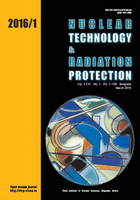
RADON MEASUREMENTS WITH CHARCOAL CANISTERS
Temperature and Humidity Considerations
Pages: 65-72
Authors: Miloš Z. Živanović, Gordana K. Pantelić, Jelena D. Krneta Nikolić, Milica M. Rajačić, and Dragana J. Todorović
Abstract
Radon testing by using open-faced charcoal canisters is a cheap and fast screening method. Many laboratories perform the sampling and measurements according to the United States Environmental Protection Agency method – EPA 520. According to this method, no corrections for temperature are applied and corrections for humidity are based on canister mass gain. The EPA method is practiced in the Vin~a Institute of Nuclear Sciences with recycled canisters. In the course of measurements, it was established that the mass gain of the recycled canisters differs from mass gain measured by Environmental Protection Agency in an active atmosphere. In order to quantify and correct these discrepancies, in the laboratory, canisters were exposed for periods of 3 and 4 days between February 2015 and December 2015. Temperature and humidity were monitored continuously and mass gain measured. No significant correlation between mass gain and temperature was found. Based on Environmental Protection Agency calibration data, functional dependence of mass gain on humidity was determined, yielding Environmental Protection Agency mass gain curves. The results of mass gain measurements of recycled canisters were plotted against these curves and a discrepancy confirmed. After correcting the independent variable in the curve equation and calculating the corrected mass gain for recycled canisters, the agreement between measured mass gain and Environmental Protection Agency mass gain curves was attained.
Key words: radon, charcoal canister, mass gain, humidity, calibration factor
FULL PAPER IN PDF FORMAT (1.03 MB)
